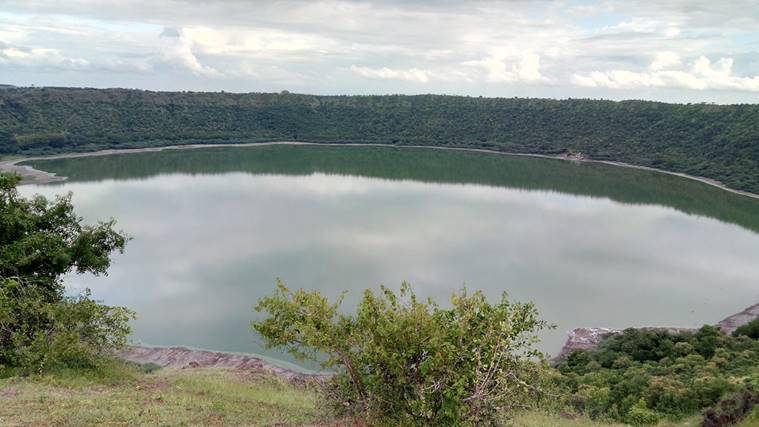- India
- International
Submit report on water in Lonar lake turning red before June 29: Bombay HC to NEERI, Agarkar institute
The directions came in response to a PIL filed by Kirti Nipankar, seeking intervention on several issues concerning the preservation of the crater- lake, considered as the largest crater-lake formed by meteor impact on basaltic land.
 The bench also directed the irrigation department to regularly collect data on water levels of the lake and dam constructed upstream for experts for comparative analysis, and give reports to the court periodically. (source: wikimedia commons)
The bench also directed the irrigation department to regularly collect data on water levels of the lake and dam constructed upstream for experts for comparative analysis, and give reports to the court periodically. (source: wikimedia commons)
The Nagpur bench of the Bombay High Court has directed NEERI and Agarkar Research Institute, Pune, to submit a report on the issue of water in the Lonar lake turning red, before June 29, along with asking the institute and GSI to study the phenomenon of “glass formation” on the lake’s surface and submit a report within four weeks.
The directions came in response to a PIL filed by Kirti Nipankar, seeking intervention on several issues concerning the preservation of the crater- lake, considered as the largest crater-lake formed by meteor impact on basaltic land.
Buldana Collector Suman Chandra has already requested NEERI to shed light on the reddening of the lake’s water. Some experts have said it is a regular annual phenomenon during the monsoon but this time it is more pronounced due to excessive algae bloom inside the lake.
The specially-constituted bench comprising Justice Sunil Shukre and Justice Anil Killor also directed visit to the site by counsel Anand Parchure for the petitioner, court-appointed committee member C S Kaptan, amicus curiae A C Dharmadhikari and government pleader Sumant Deopujari.
The bench also directed the irrigation department to regularly collect data on water levels of the lake and dam constructed upstream for experts for comparative analysis, and give reports to the court periodically.

The court further directed that the work on a road from Lonar to Kinhi, which the forest department said is in the eco-sensitive zone of the lake, be stopped immediately till the final outcome of the case. The directive came in the light of the submission by the forest department that the road passes through the lake’s “ejecta blanket”, the material thrown out of the place after the meteor hit and spread around the circular crater.
“This material has been found to be containing the same substance as found on the moon, and it is of a kind found just prior to the formation of a diamond. If it is true that some part of Lonar-Kinhi road passes through an eco-sensitive zone, it would be necessary for the authorities to consider moving it to some other site. The authorities will have to take appropriate measures to prevent any kind of interference, pilferage and theft in the area,” stated the court, directing the public works department to submit, through an affidavit, information regarding “environmental impact assessment and necessary permission for construction of this road having been granted by the eco-sensitive zone committee and also environmental authorities”.
The bench also directed the Lonar municipal authorities to prevent open defecation not only in the vicinity of the lake but also in the town. “If citizens do not show any obedience to and respect for the law, appropriate penal measures should be taken. If necessary, assistance from NGOs and police shall be taken,” the court said.
Addressing the concern of the forest department that the PWD rest house constructed before the whole area was declared a sanctuary should be handed over to it for controlling visitors’ access and for protecting ejecta blanket, the court directed the PWD to submit a proposal to the government and “submit its copy to the court-appointed committee before the next date of hearing, June 29”.
Apr 18: Latest News
- 01
- 02
- 03
- 04
- 05






































